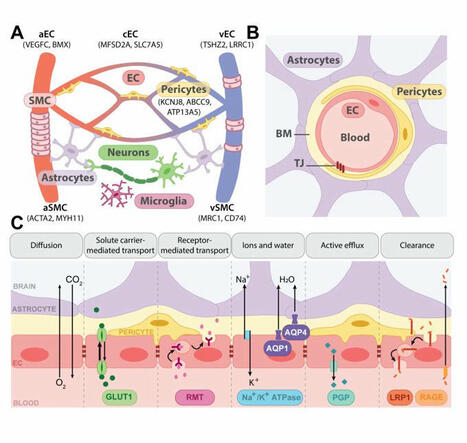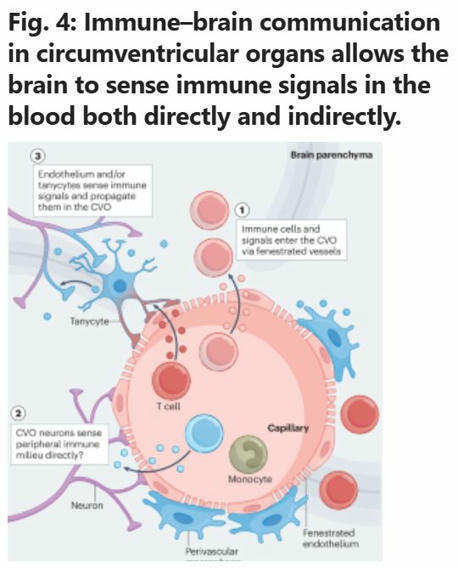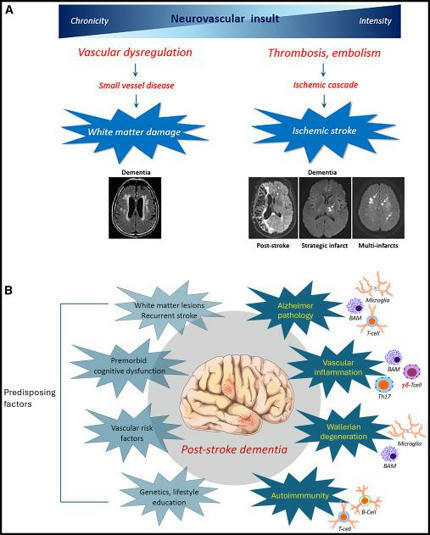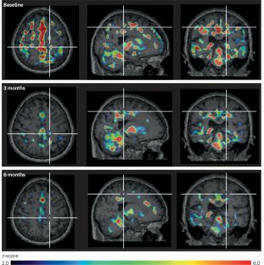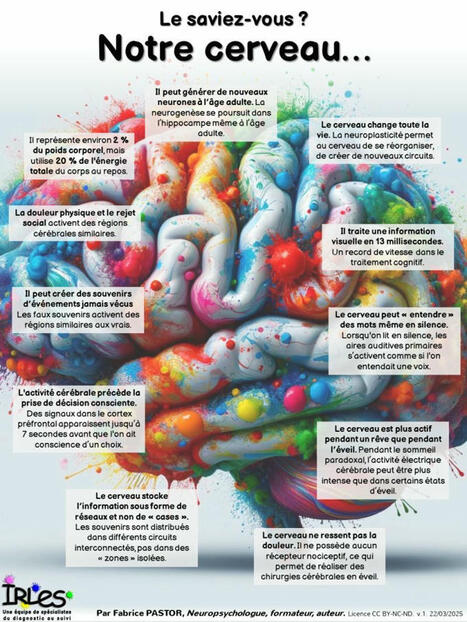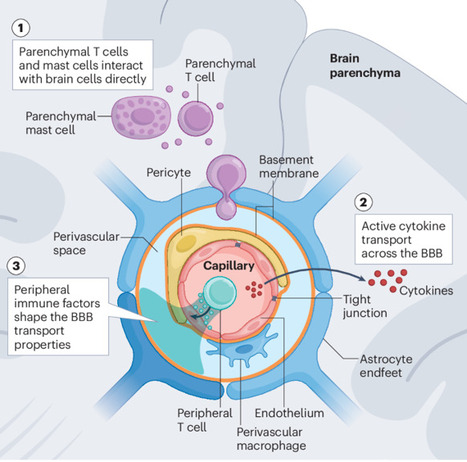 Your new post is loading...
 Your new post is loading...

|
Scooped by
Gilbert C FAURE
October 17, 2022 11:45 AM
|
This topic is devoted to Neuro-immunology, covering various neurological disorders with confirmed or possible immunological mechanisms. This year (2022), many students are choosing Neurology and neurological diseases for their Scoop.it exercise. It will stimulate me for improving this topic (tagging...) to help them navigate the curated resources. Some key points: We developed original research on Choroid Plexuses in ageing and Alzheimer's disease. https://www.scoop.it/topic/neuroimmunology?q=choroid+plexuses The topic of autoimmunity at large, became very fashionable recently. https://www.scoop.it/topic/neuroimmunology?q=autoimmunity with prescription of many biological tests for diagnosis of difficult neurological clinical disorders. We were also very much involved, 15 years ago in the development of CSFTCs detection, enumeration and analysis in carcinoma meningitis, a rare but dramatic issue in breast, lung ... cancers and melanomas. Papers on https://www.scoop.it/topic/nancytomique

|
Scooped by
Gilbert C FAURE
May 7, 10:14 AM
|

|
Scooped by
Gilbert C FAURE
April 23, 7:20 AM
|

|
Scooped by
Gilbert C FAURE
March 21, 5:20 AM
|
🧠🧬 Focus sur les cellules CAR-T en neurologie, ainsi que sur des dossiers transversaux et la pharmacologie. Encore un numéro incontournable de 𝙇𝙖…

|
Scooped by
Gilbert C FAURE
February 25, 4:18 AM
|
New review from our lab published in BRAIN
We explore how molecular blood-brain barrier (BBB) changes in aging, neurodegeneration and stroke affect disease…

|
Scooped by
Gilbert C FAURE
February 13, 6:48 AM
|
There is a misconception that only amyloid-targeting treatments have been studied in Alzheimer's disease. The reality is that clinical trials have evaluated… | 21 comments on LinkedIn

|
Scooped by
Gilbert C FAURE
February 10, 2:43 AM
|
Immune control of brain physiology
Contrary to the classical view of immune-brain communication as a dormant system activated only during pathology, this…

|
Scooped by
Gilbert C FAURE
February 4, 5:06 AM
|
In this post, I am sharing the Physiology of CSF (Cerebrospinal Fluid).
Cerebrospinal fluid (CSF) is a clear, colorless fluid that surrounds the brain and…

|
Scooped by
Gilbert C FAURE
January 20, 1:39 PM
|

|
Scooped by
Gilbert C FAURE
January 16, 4:13 AM
|
L’apport de l’immunologie dépasse la seule compréhension de la physiopathologie des déficits immunitaires, de l’allergie ou des maladies auto immunes mais…

|
Scooped by
Gilbert C FAURE
January 12, 5:34 AM
|
Long COVID (also known as post-acute sequelae of SARS-CoV-2 infection [PASC] or post-COVID syndrome) is characterized by persistent symptoms that extend beyond the acute phase of SARS-CoV-2 infection, affecting approximately 10% to over 30% of those infected. It presents a significant clinical challenge, notably due to pronounced neurocognitive symptoms such as brain fog. The mechanisms underlying these effects are multifactorial, with mounting evidence pointing to a central role of cerebromicrovascular dysfunction. This review investigates key pathophysiological mechanisms contributing to cerebrovascular dysfunction in long COVID and their impacts on brain health. We discuss how endothelial tropism of SARS-CoV-2 and direct vascular infection trigger endothelial dysfunction, impaired neurovascular coupling, and blood–brain barrier disruption, resulting in compromised cerebral perfusion. Furthermore, the infection appears to induce mitochondrial dysfunction, enhancing oxidative stress and inflammation within cerebral endothelial cells. Autoantibody formation following infection also potentially exacerbates neurovascular injury, contributing to chronic vascular inflammation and ongoing blood–brain barrier compromise. These factors collectively contribute to the emergence of white matter hyperintensities, promote amyloid pathology, and may accelerate neurodegenerative processes, including Alzheimer’s disease. This review also emphasizes the critical role of advanced imaging techniques in assessing cerebromicrovascular health and the need for targeted interventions to address these cerebrovascular complications. A deeper understanding of the cerebrovascular mechanisms of long COVID is essential to advance targeted treatments and mitigate its long-term neurocognitive consequences.

|
Scooped by
Gilbert C FAURE
January 6, 4:10 AM
|
I have started the new year reading many research articles on chronic inflammation. It is incredible to me how much chronic inflammation is a driver for almost…

|
Scooped by
Gilbert C FAURE
January 2, 4:33 AM
|
The immune system is increasingly recognized as a key player in neurodegenerative diseases, with its roles ranging from being a primary driver (as in multiple…
|

|
Scooped by
Gilbert C FAURE
May 15, 1:38 PM
|
Independent of antigen presentation, migratory CCR7+ dendritic cells orchestrate the influx, proliferation and cytotoxic action of natural killer cells to control cancer cell growth in the leptomeninges.

|
Scooped by
Gilbert C FAURE
May 5, 4:11 AM
|

|
Scooped by
Gilbert C FAURE
March 28, 4:51 AM
|
Les ressources de notre cerveau sont exceptionnelles et souvent méconnues. Par exemple, il continue à générer de nouveaux neurones, même à l’âge adulte. Il… | 26 comments on LinkedIn

|
Scooped by
Gilbert C FAURE
March 3, 9:51 AM
|
🧠 Glymphatic system: a self-purification circulation in brain🌊💡
The glymphatic system offers a fresh perspective on fluid dynamics and homeostasis in the… | 13 comments on LinkedIn

|
Scooped by
Gilbert C FAURE
February 22, 8:54 AM
|

|
Scooped by
Gilbert C FAURE
February 10, 4:15 AM
|
𝐂𝐞𝐥𝐥 𝐓𝐡𝐞𝐫𝐚𝐩𝐲 𝐢𝐧 𝐍𝐞𝐮𝐫𝐨𝐬𝐜𝐢𝐞𝐧𝐜𝐞 𝐋𝐚𝐧𝐝𝐬𝐜𝐚𝐩𝐞 🧠
With 50+ companies tackling 600+ neurological disorders, the opportunity to impact… | 17 comments on LinkedIn

|
Scooped by
Gilbert C FAURE
February 9, 4:15 AM
|

|
Scooped by
Gilbert C FAURE
January 31, 1:23 PM
|
The peripheral immune system communicates with the brain through complex anatomical routes involving the skull, the brain borders, circumventricular organs and peripheral nerves. These immune–brain communication pathways were classically considered to be dormant under physiological conditions and active only in cases of infection or damage. Yet, peripheral immune cells and signals are key in brain development, function and maintenance. In this Perspective, we propose an alternative framework for understanding the mechanisms of immune–brain communication. During brain development and in homeostasis, these anatomical structures allow selected elements of the peripheral immune system to affect the brain directly or indirectly, within physiological limits. By contrast, in ageing and pathological settings, detrimental peripheral immune signals hijack the existing communication routes or alter their structure. We discuss why a diversity of communication channels is needed and how they work in relation to one another to maintain homeostasis of the brain. The peripheral immune system communicates with the brain through diverse anatomical routes to shape brain physiology. Here we discuss why such diversity is needed and explore how these routes are leveraged during development and hijacked in ageing.

|
Scooped by
Gilbert C FAURE
January 20, 6:48 AM
|
A comprehensive study mapped neuronal IL-1R1 (nIL-1R1) expression in the mouse brain, highlighting its role in sensory processing, mood, and memory regulation.

|
Scooped by
Gilbert C FAURE
January 13, 4:45 AM
|
Kwon HS, Koh SH. Monoclonal Antibodies-A New Horizon in Alzheimer's Treatment. J Clin Neurol. 2025 Jan;21(1):1-2. PubMed.

|
Scooped by
Gilbert C FAURE
January 9, 2:58 AM
|
@BrainInflCollab: In 2017 Alina Sternberg, a psychiatrist, was hit with crushing fatigue and brain fog. Neurologists told her the symptoms were caused by depression. "No, I can enjoy my life and I know what depressi...…

|
Scooped by
Gilbert C FAURE
from Neuroimmunology TV
January 5, 5:29 AM
|
Peripheral immune regulation by Vit D protects against CNS inflammation by regulating the activation of microglia and astrocytes in the brain parenchyma and maintaining BBB integrity (92). Within the BBB, endothelial cells are joined together through tight junctions.
Via VENIER Thomas

|
Scooped by
Gilbert C FAURE
December 19, 2024 7:01 AM
|
The evolving pathophysiological landscape of Alzheimer’s disease (AD) research increasingly indicates an intricate interplay between the brain and the immune… | 18 comments on LinkedIn
|






 Your new post is loading...
Your new post is loading...


